Stiffness Modeling and Dynamics Co-Modeling for Space Cable-Driven Linkage Continuous Manipulators
Abstract
1. Introduction
- (1)
- The cable was equivalently simplified as a spring model, ignoring the mass and damping effects;
- (2)
- We ignored the hysteresis phenomenon in the movement of the manipulator;
- (3)
- Only the friction between the cable and the perforated disc was considered, and other frictions were ignored.
2. Kinematics Model
2.1. Description of the SCCM
2.2. Single Cross-Axis Joint Angle to Cable Length
2.3. Manipulator Joint Angle to Cable Length
2.4. Joint Space to Task Space
3. Stiffness Model
3.1. Equivalent Stiffness Modeling of Linkage Cable
3.2. Equivalent Stiffness Modeling of Driving Cable
3.3. The Cartesian Space Equivalent Stiffness of the End
4. Dynamics Modeling and Simulation
4.1. Dynamics Equation
4.2. Dynamics Co-Modeling Method
5. Simulation Analysis
5.1. End Cartesian Space Stiffness
5.2. The Influence of Cable Tension on the End Cartesian Space Stiffness
5.3. The Influence of Cable Tension on Manipulator Frequency
5.4. Dynamics Simulation
5.5. Slit Crossing Experiment
6. Conclusions
- We established the complete stiffness model of the SCCM and analyzed the stiffness characteristics of the end under a specific configuration based on the stiffness model. The stiffness of the manipulator came from two parts: linkage cables and driving cables. The stiffness of the driving cable was not only related to the physical parameters of the cable itself, but also related to the tension of the cable. Based on the stiffness model, the influence of the active tension of cable on the stiffness of the robot was discussed, which provided the basis for the next stiffness control.
- A co-modeling and co-simulation method of the SCCM’s dynamics was proposed, which not only ensured the accuracy of the simulation, but also greatly improved the modeling efficiency. The manipulator not only had many DOFs, but also had a large number of cable units. The dynamic modeling was carried out by combining the algorithm with commercial software, which can give full play to the advantages of the rigid model calculation of the dynamic commercial software and ensure the efficiency of the cable friction calculation. This method is suitable for model expansion for large-scale system co-simulation, which greatly reduces the simulation workload.
Author Contributions
Funding
Institutional Review Board Statement
Informed Consent Statement
Data Availability Statement
Conflicts of Interest
References
- McMahan, W.; Jones, B.; Walker, I. Design and implementation of a multi-section continuum robot: Air-Octor. In Proceedings of the 2005 IEEE/RSJ International Conference on Intelligent Robots and Systems, Edmonton, AB, Canada, 2–6 August 2005; pp. 2578–2585. [Google Scholar] [CrossRef]
- Qi, P.; Qiu, C.; Liu, H.; Dai, J.S.; Seneviratne, L.D.; Althoefer, K. A Novel Continuum Manipulator Design Using Serially Connected Double-Layer Planar Springs. IEEE/ASME Trans. Mechatron. 2016, 21, 1281–1292. [Google Scholar] [CrossRef]
- Gao, G.; Wang, H.; Xia, Q.; Song, M.; Ren, H. Study on the load capacity of a single-section continuum manipulator. Mech. Mach. Theory 2016, 104, 313–326. [Google Scholar] [CrossRef]
- Li, Z.; Wu, L.; Ren, H.; Yu, H. Kinematic comparison of surgical tendon-driven manipulators and concentric tube manipulators. Mech. Mach. Theory 2017, 107, 148–165. [Google Scholar] [CrossRef]
- Yang, J.; Peng, H.; Zhou, W.; Zhang, J.; Wu, Z. A modular approach for dynamic modeling of multisegment continuum robots. Mech. Mach. Theory 2021, 165, 104429. [Google Scholar] [CrossRef]
- Ning, K.; Wörgötter, F. Control System Development for a Novel Wire-Driven Hyper-Redundant Chain Robot, 3D-Trunk. IEEE/ASME Trans. Mechatron. 2012, 17, 949–959. [Google Scholar] [CrossRef]
- Tonapi, M.M.; Godage, I.S.; Walker, I.D. Next generation rope-like robot for in-space inspection. In Proceedings of the 2014 IEEE Aerospace Conference, Big Sky, MT, USA, 1–8 March 2014; pp. 1–13. [Google Scholar] [CrossRef]
- Wooten, M.B.; Walker, I.D. A Novel Vine-Like Robot for In-Orbit Inspection. In Proceedings of the 45th International Conference on Environmental Systems, Bellevue, WA, USA, 12 July 2015. [Google Scholar]
- Nahar, D.; Yanik, P.M.; Walker, I.D. Robot tendrils: Long, thin continuum robots for inspection in space operations. In Proceedings of the IEEE Aerospace Conference, Big Sky, MT, USA, 4–11 March 2017; pp. 1–8. [Google Scholar] [CrossRef]
- Xu, W.; Mu, Z.; Liu, T.; Liang, B. A modified modal method for solving the mission-oriented inverse kinematics of hyper-redundant space manipulators for on-orbit servicing. Acta Astronaut. 2017, 139, 54–66. [Google Scholar] [CrossRef]
- Dong, X.; Axinte, D.; Palmer, D.; Cobos, S.; Raffles, M.; Rabani, A.; Kell, J. Development of a slender continuum robotic system for on-wing inspection/repair of gas turbine engines. Robot. Comput. Integr. Manuf. 2017, 44, 218–229. [Google Scholar] [CrossRef]
- Peng, J.; Xu, W.; Liu, T.; Yuan, H.; Liang, B. End-effector pose and arm-shape synchronous planning methods of a hyper-redundant manipulator for spacecraft repairing. Mech. Mach. Theory 2021, 155, 104062. [Google Scholar] [CrossRef]
- Liu, T.; Mu, Z.; Wang, H.; Xu, W.; Li, Y. A Cable-Driven Redundant Spatial Manipulator with Improved Stiffness and Load Capacity. In Proceedings of the 2018 IEEE/RSJ International Conference on Intelligent Robots and Systems (IROS), Madrid, Spain, 1–5 October 2018; pp. 6628–6633. [Google Scholar] [CrossRef]
- Liu, T.; Mu, Z.; Xu, W.; Yang, T.; You, K.; Fu, H.; Li, Y. Improved Mechanical Design and Simplified Motion Planning of Hybrid Active and Passive Cable-Driven Segmented Manipulator with Coupled Motion. In Proceedings of the 2019 IEEE/RSJ International Conference on Intelligent Robots and Systems (IROS), Macau, China, 3–8 November 2019; pp. 5978–5983. [Google Scholar] [CrossRef]
- Liu, T.; Xu, W.; Yang, T.; Li, Y. A Hybrid Active and Passive Cable-Driven Segmented Redundant Manipulator: Design, Kinematics, and Planning. IEEE/ASME Trans. Mechatron. 2021, 26, 930–942. [Google Scholar] [CrossRef]
- Wang, Y.; Yang, G.; Yang, K.; Zheng, T. The kinematic analysis and stiffness optimization for an 8-DOF cable-driven manipulator. In Proceedings of the 2017 IEEE International Conference on Cybernetics and Intelligent Systems (CIS) and IEEE Conference on Robotics, Automation and Mechatronics (RAM), Ningbo, China, 19–21 November 2017; pp. 682–687. [Google Scholar] [CrossRef]
- Oliver-Butler, K.; Till, J.; Rucker, C. Continuum Robot Stiffness Under External Loads and Prescribed Tendon Displacements. IEEE Trans. Robot. 2019, 35, 403–419. [Google Scholar] [CrossRef]
- Gu, H.; Wei, C.; Zhang, Z.; Zhao, Y. Theoretical and Experimental Study on Active Stiffness Control of a Two-Degrees-of-Freedom Rope-Driven Parallel Mechanism. J. Mech. Robot. 2021, 13, 011018. [Google Scholar] [CrossRef]
- Zhang, J.; Li, Q.; Chen, W.; Fang, Z.; Yang, G. Design and Stiffness Analysis of a Cable-Driven Continuum Manipulator. In Proceedings of the 2021 IEEE 16th Conference on Industrial Electronics and Applications (ICIEA), Chengdu, China, 1–4 August 2021; pp. 2026–2031. [Google Scholar] [CrossRef]
- Yuan, H.; Zhang, W.; Dai, Y.; Xu, W. Analytical and numerical methods for the stiffness modeling of cable-Driven serpentine manipulators. Mech. Mach. Theory 2021, 156, 104179. [Google Scholar] [CrossRef]
- Xu, W.; Liu, T.; Li, Y. Kinematics, Dynamics, and Control of a Cable-Driven Hyper-Redundant Manipulator. IEEE/ASME Trans. Mechatron. 2018, 23, 1693–1704. [Google Scholar] [CrossRef]
- Ma, S.; Liang, B.; Wang, T. Dynamic analysis of a hyper-redundant space manipulator with a complex rope network. Aerosp. Sci. Technol. 2020, 100, 105768. [Google Scholar] [CrossRef]
- Zhou, Z.; Zheng, X.; Chen, Z.; Wang, X.; Liang, B.; Wang, Q. Dynamics modeling and analysis of cable-driven segmented manipulator considering friction effects. Mech. Mach. Theory 2022, 169, 104633. [Google Scholar] [CrossRef]
- Li, Y.; Liu, Y.; Meng, D.; Wang, X.; Liang, B. Modeling and Experimental Verification of a Cable-Constrained Synchronous Rotating Mechanism Considering Friction Effect. IEEE Robot. Autom. Lett. 2020, 5, 5464–5471. [Google Scholar] [CrossRef]
- Hu, Q.; Jia, Y.; Xu, S. A new computer-oriented approach with efficient variables for multibody dynamics with motion constraints. Acta Astronaut. 2012, 81, 380–389. [Google Scholar] [CrossRef]
- Hu, Q.; Jia, Y.; Xu, S. Recursive Dynamics Algorithm for Multibody Systems with Variable-Speed Control Moment Gyroscopes. J. Guid. Control. Dyn. 2013, 36, 1388–1398. [Google Scholar] [CrossRef]

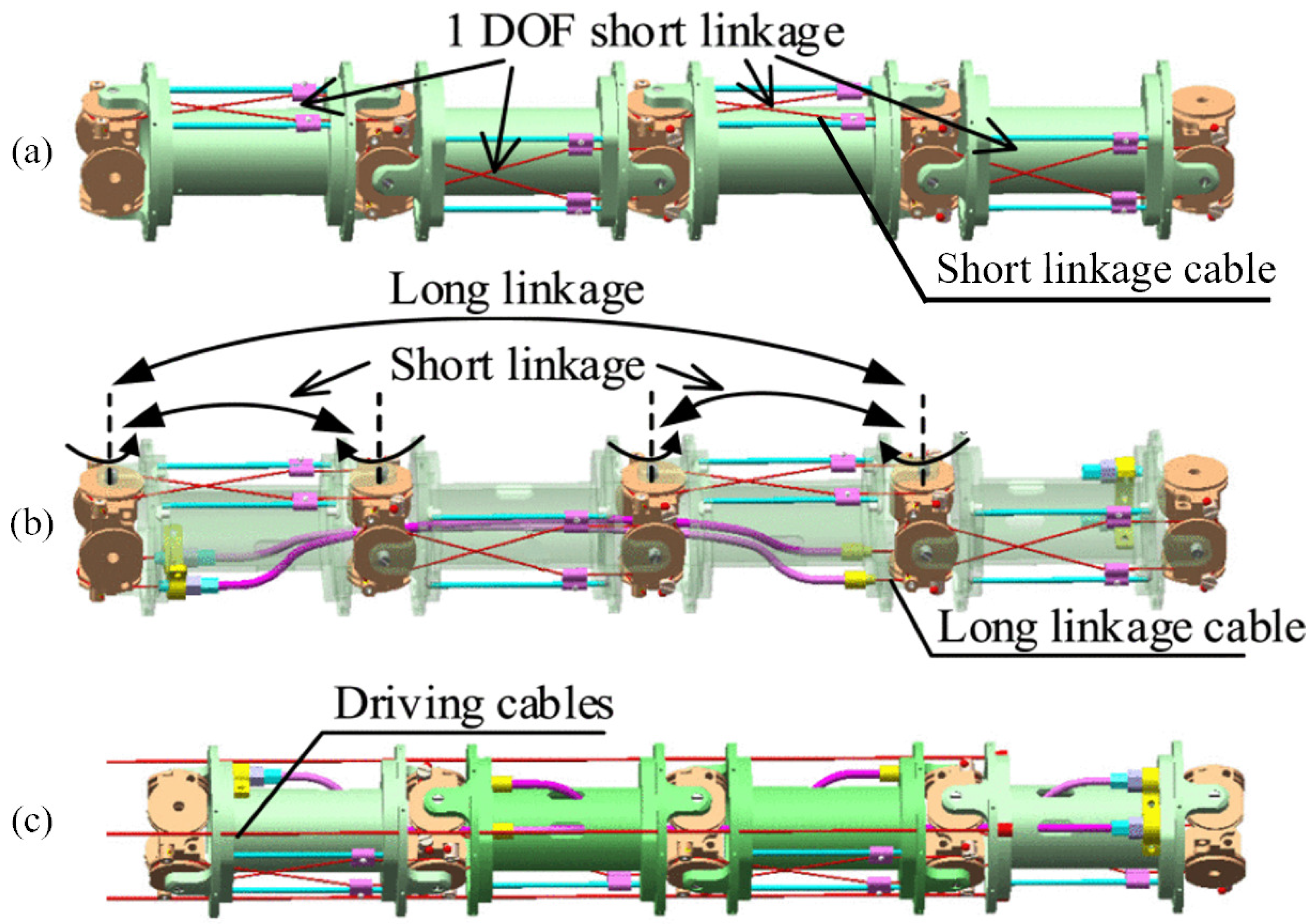
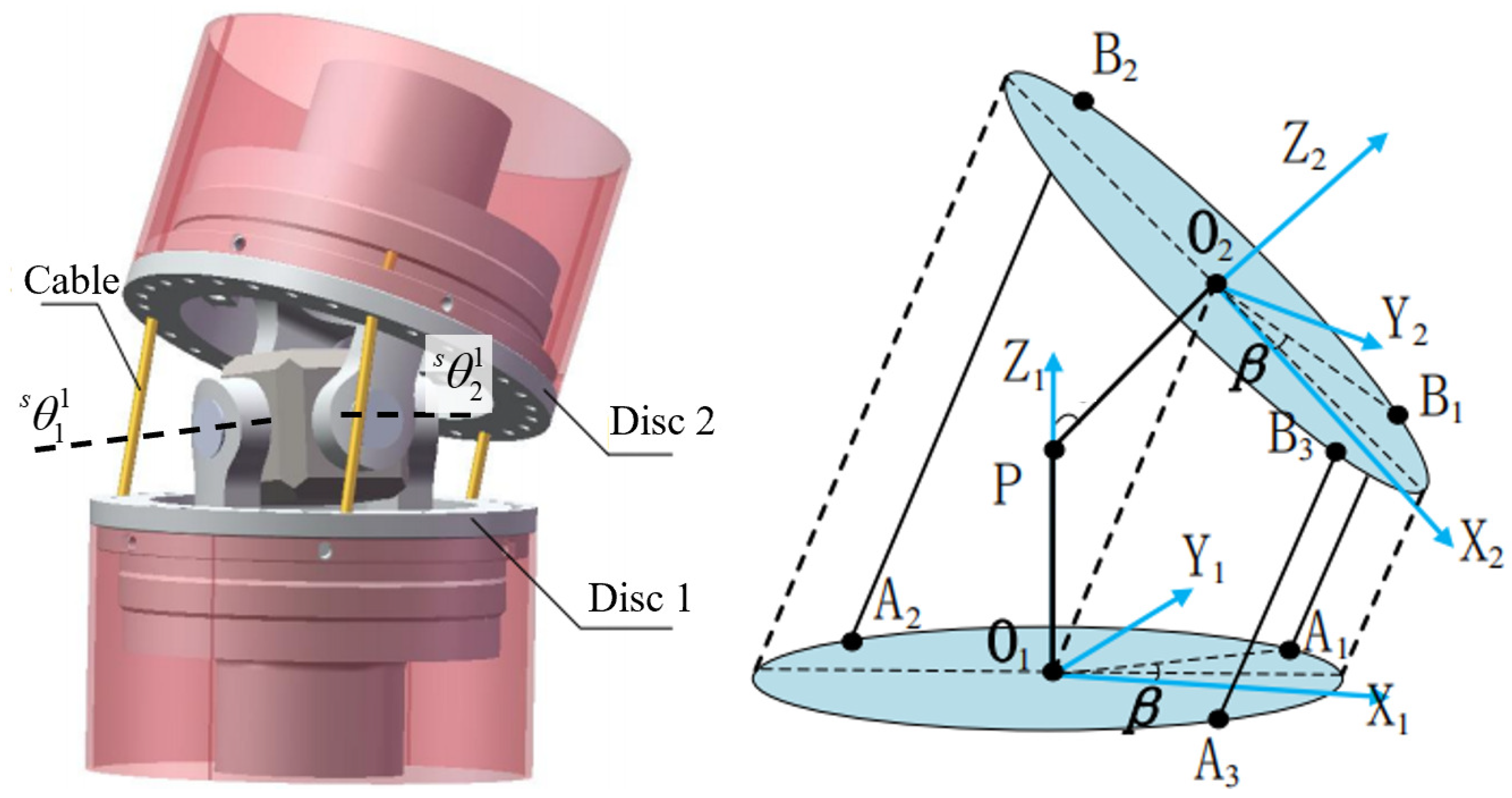


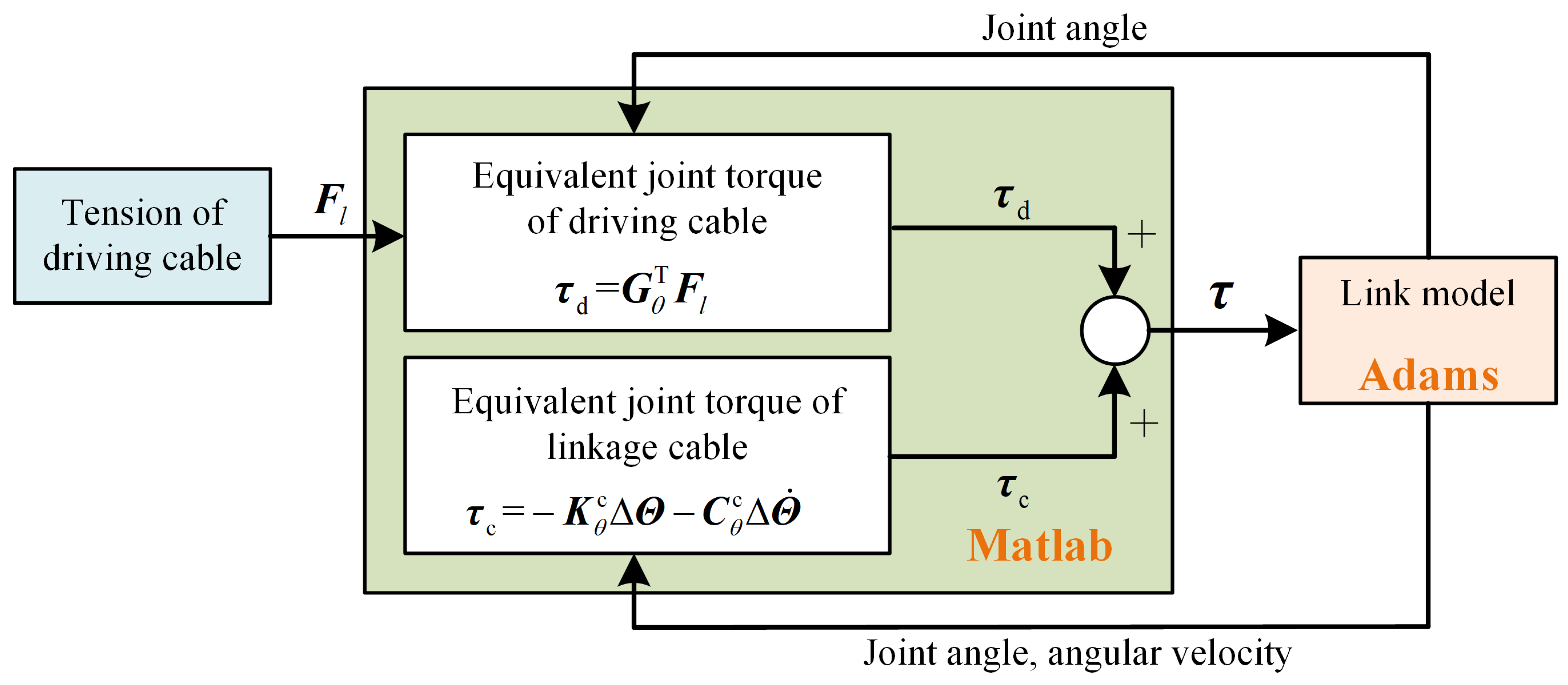

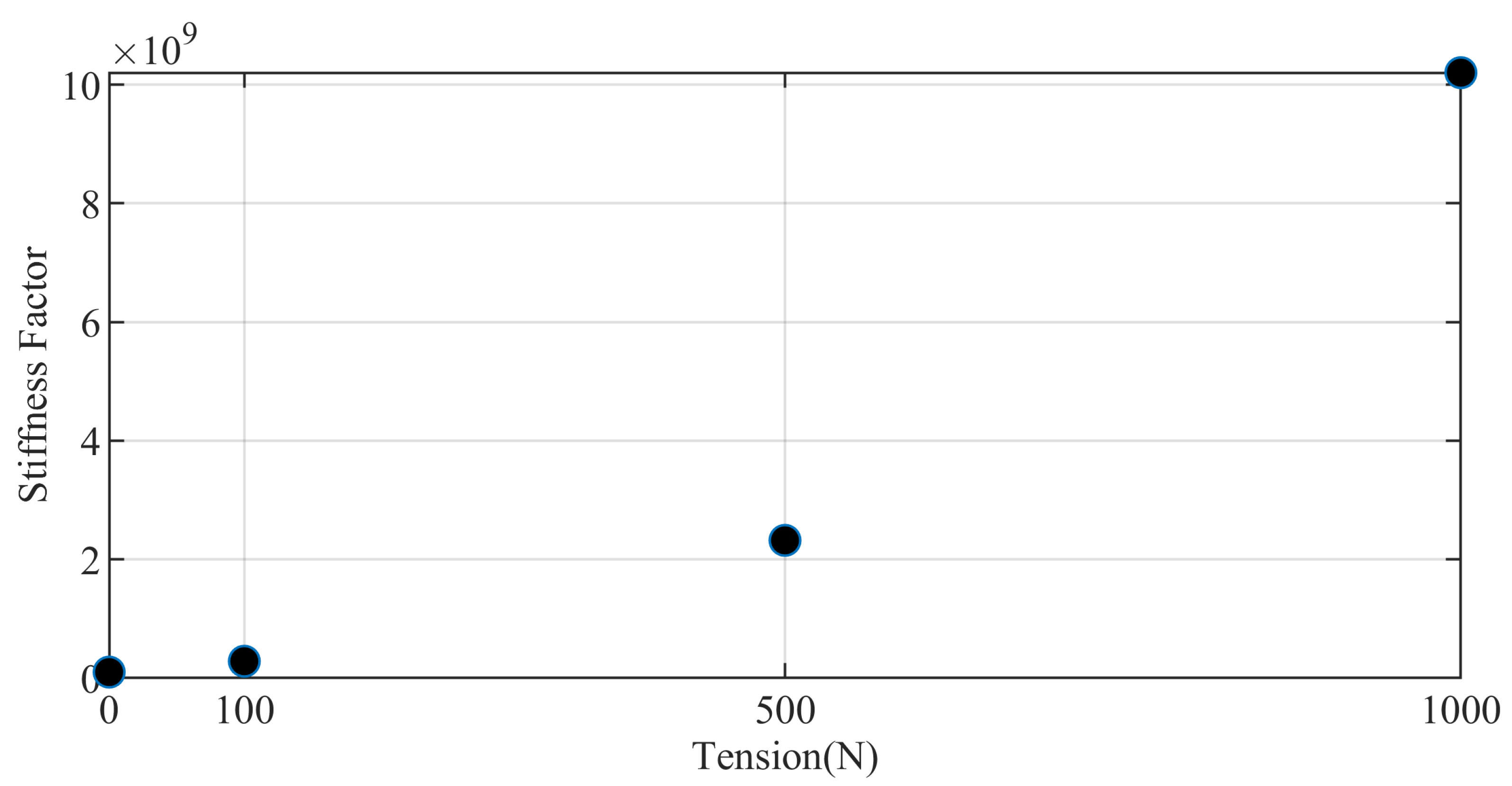
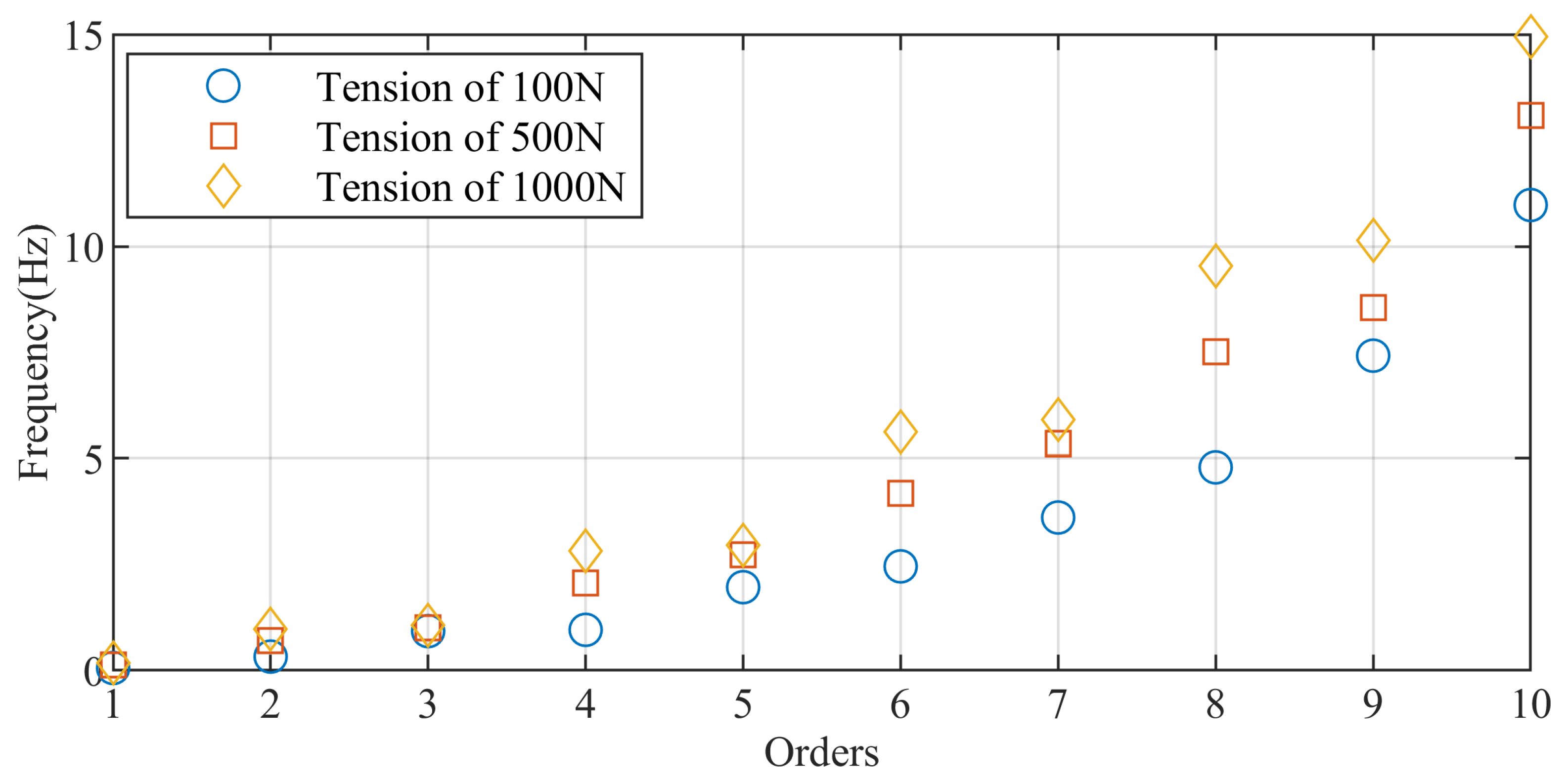
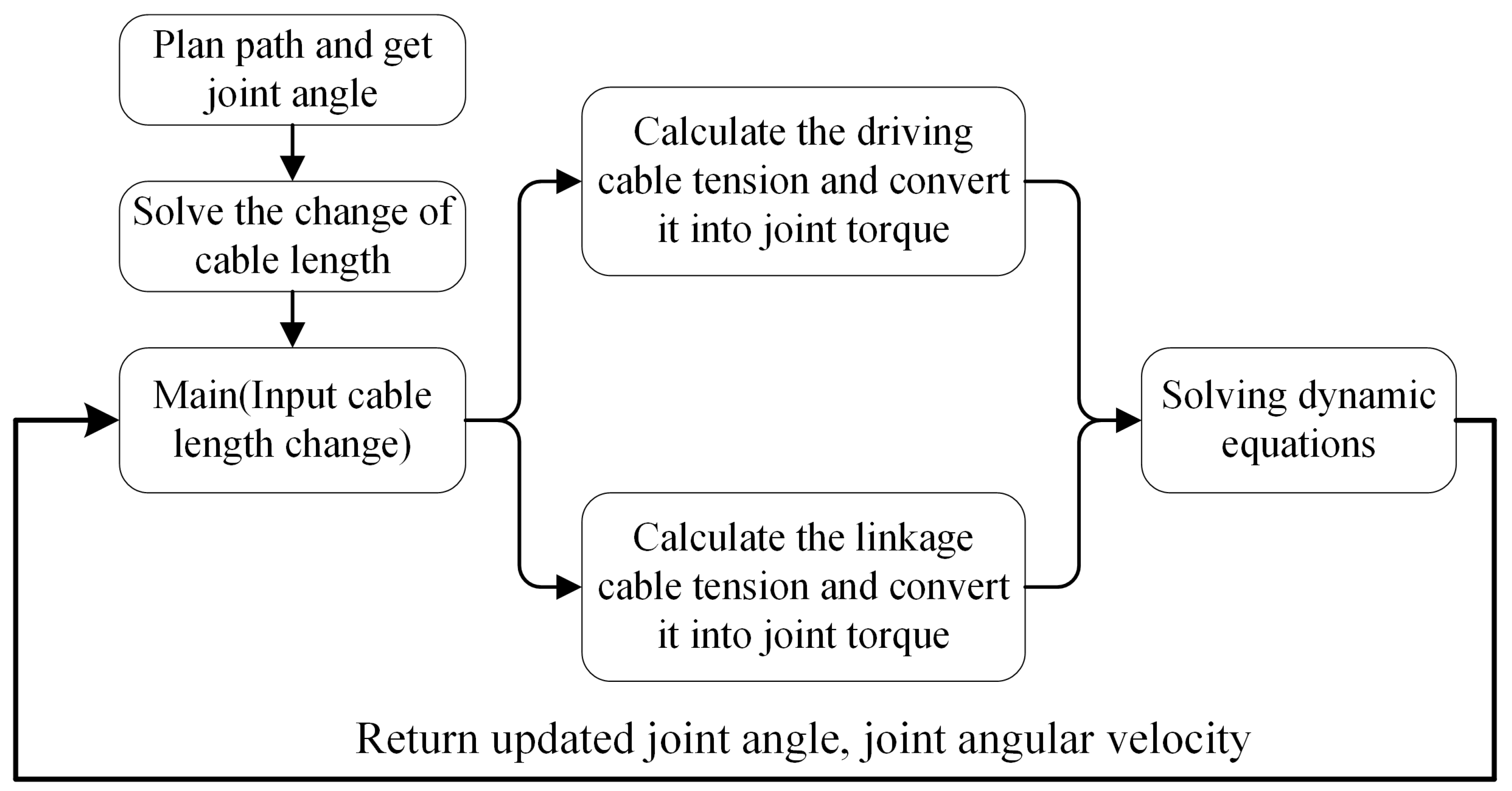

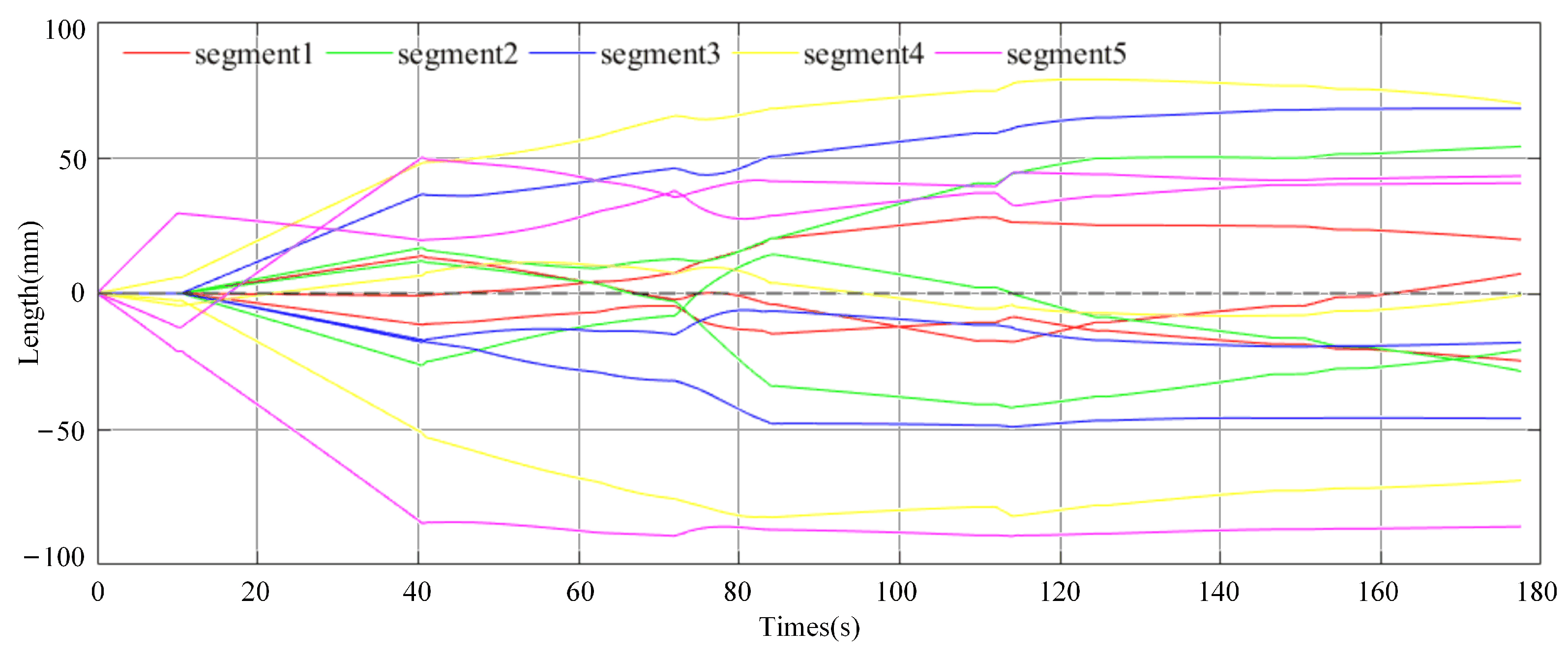


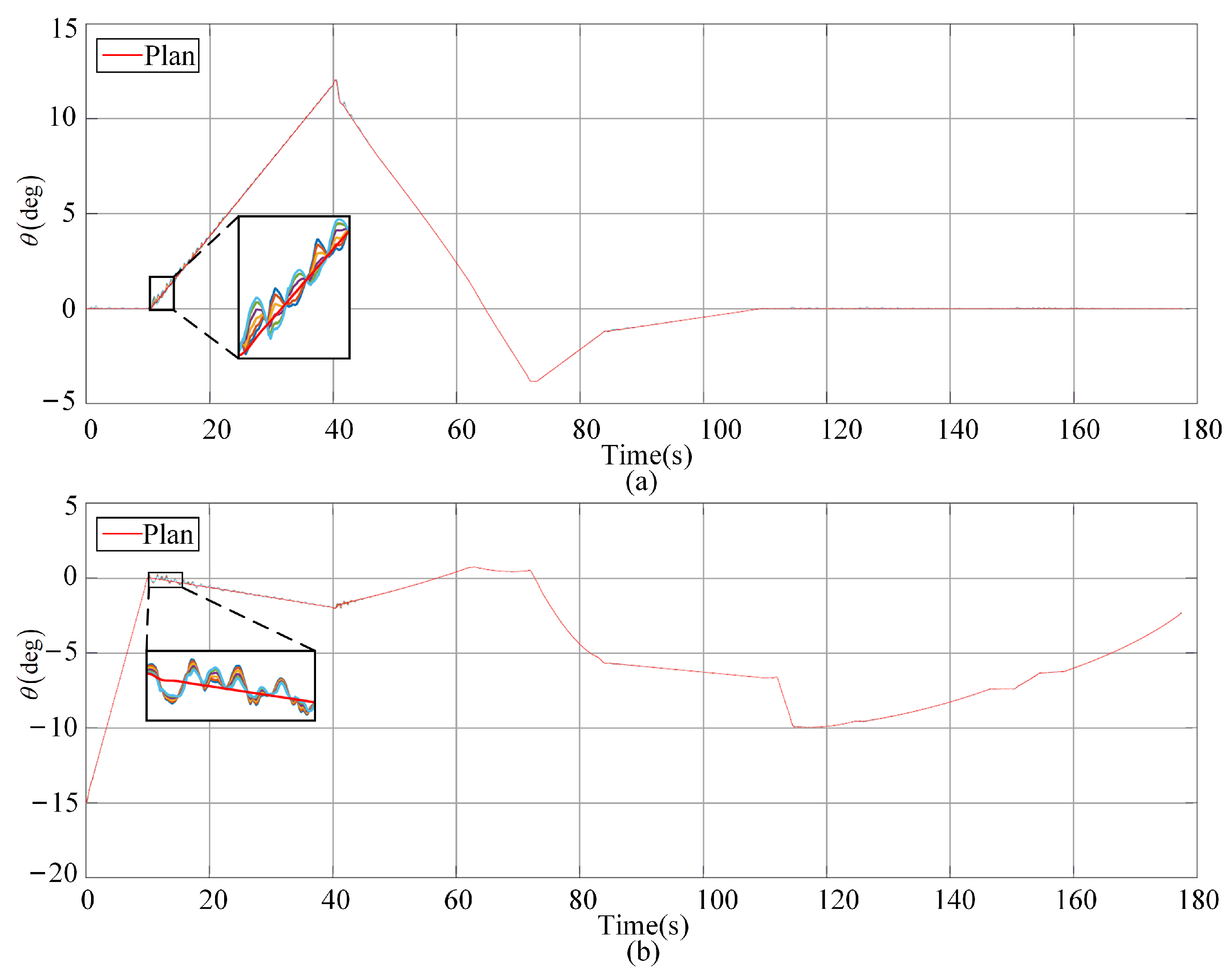
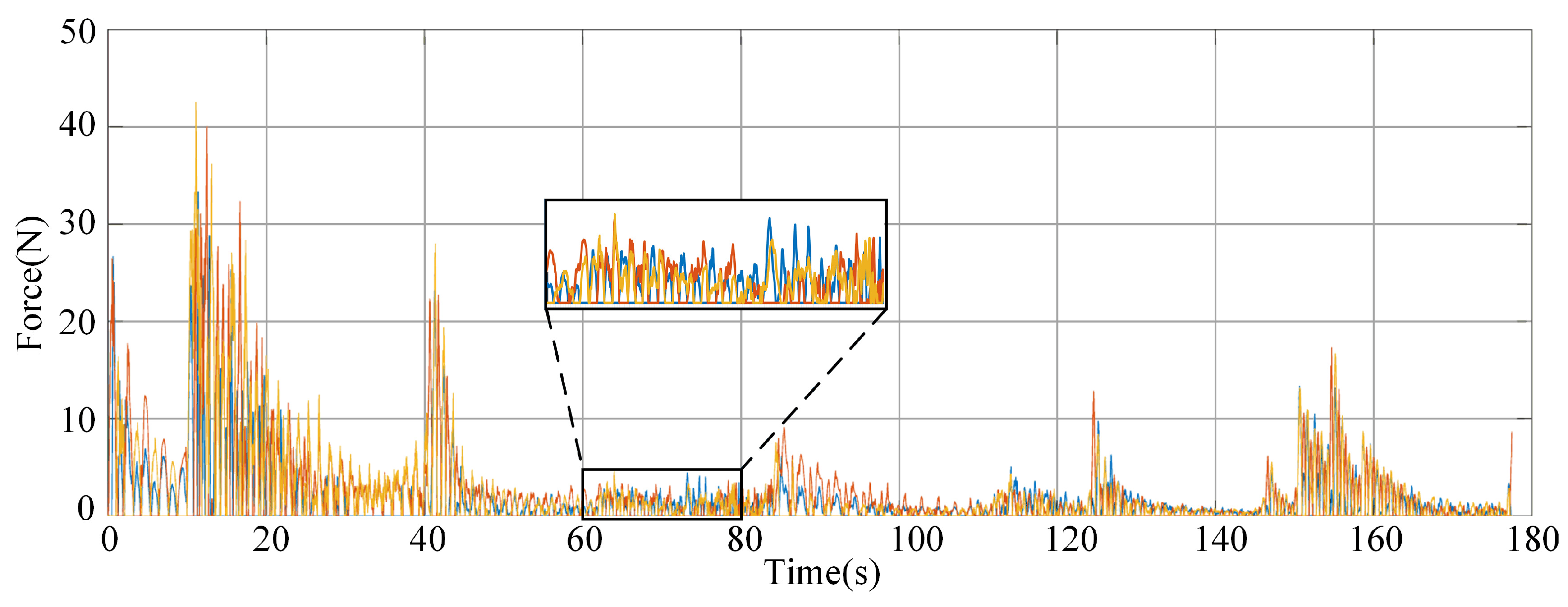


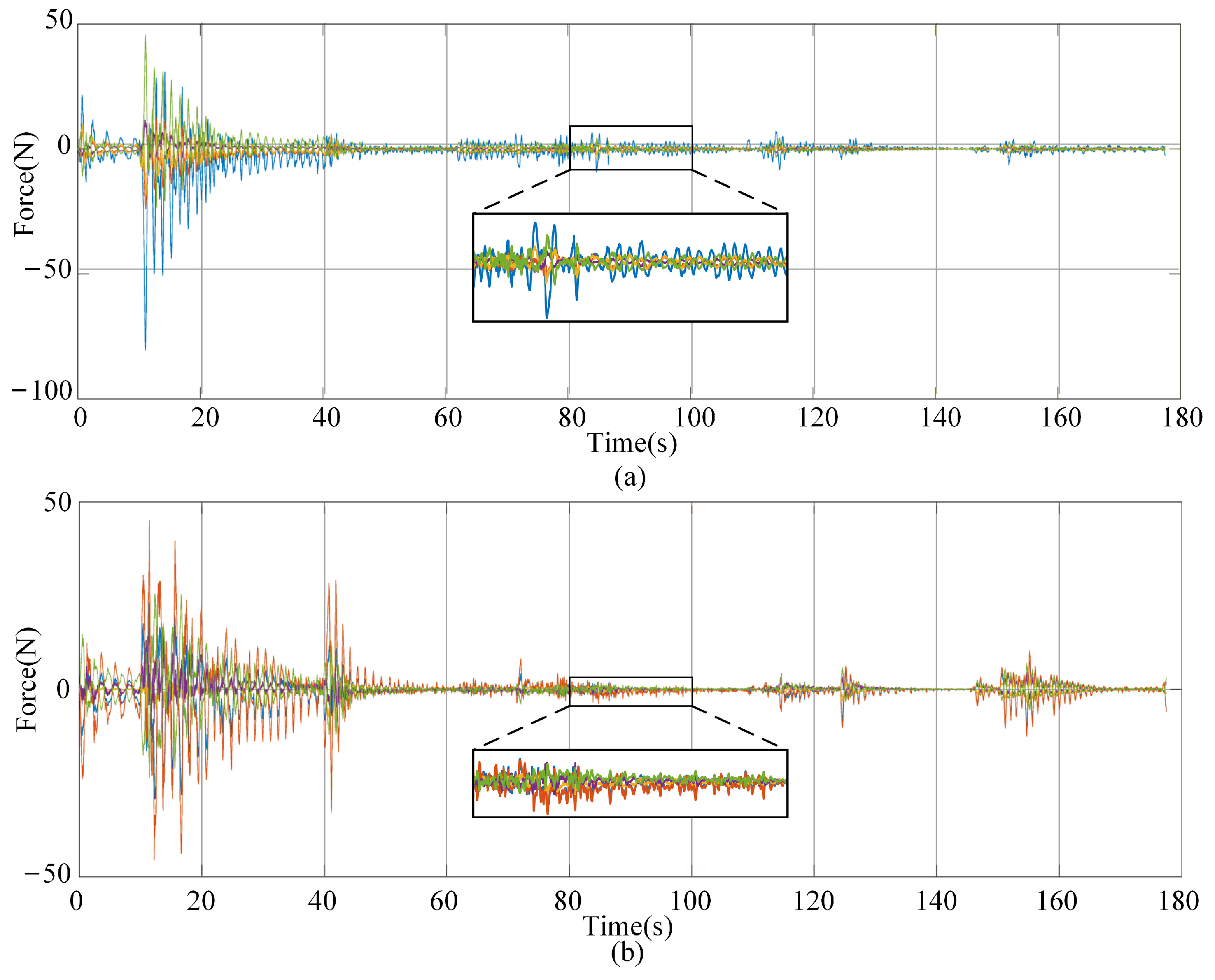
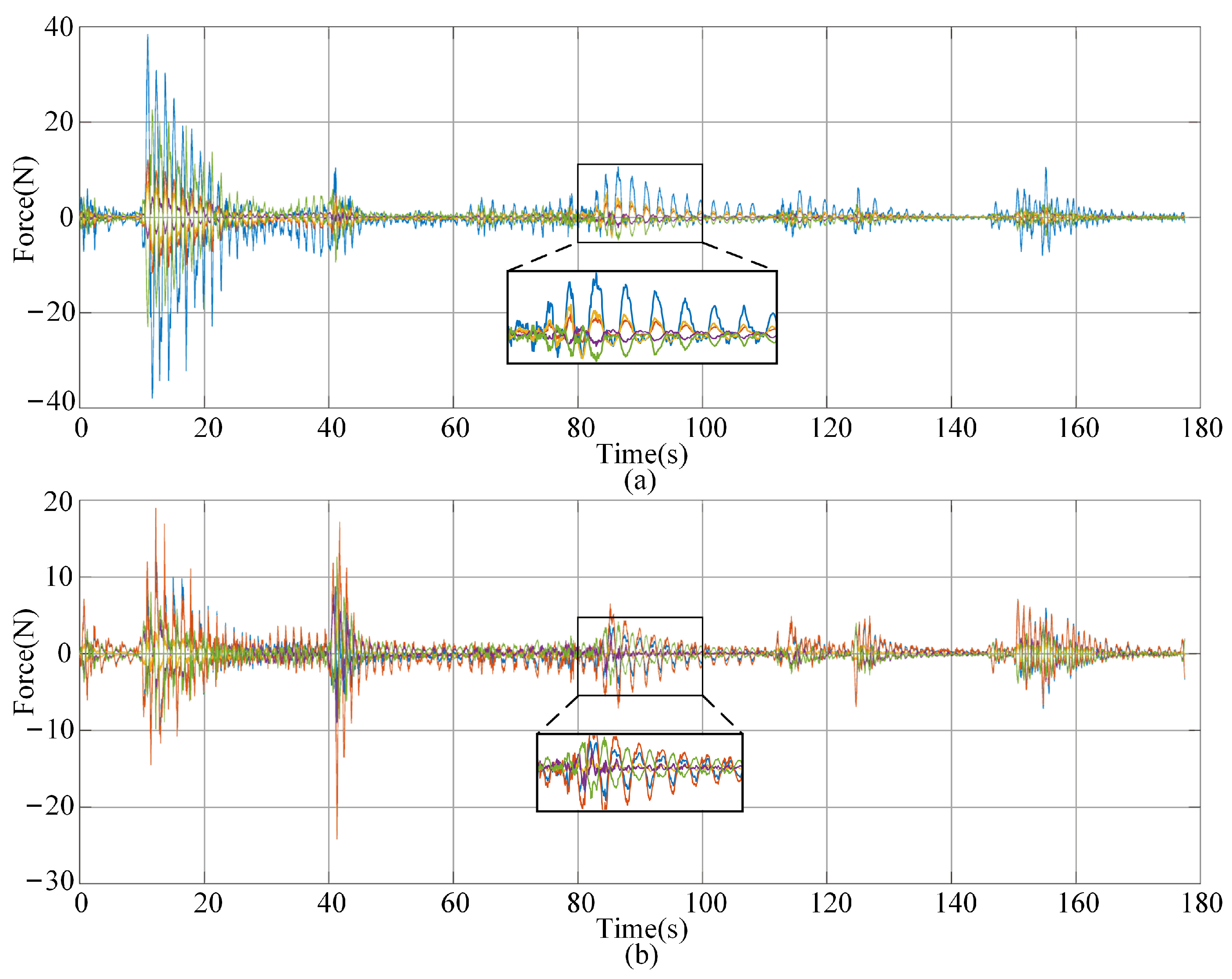
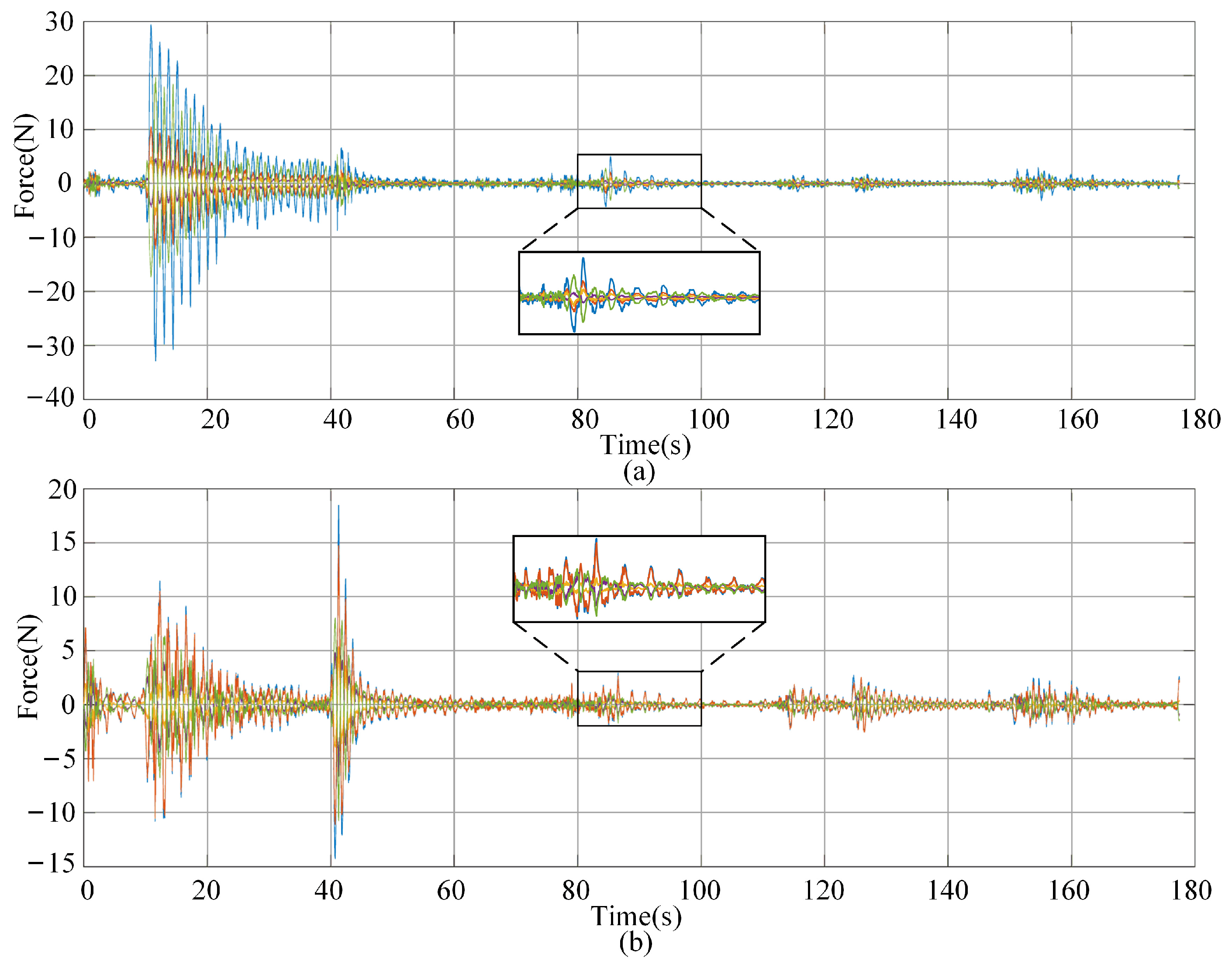


| Link i | ||||
|---|---|---|---|---|
| 1 | 0 | −90 | 0 | |
| 2 | 0 | 0 | ||
| 3 | 0 | 90 | 0 | |
| 4 | 0 | 0 | ||
| ⋮ | ⋮ | ⋮ | ⋮ | ⋮ |
| 0 | 90 | 0 | ||
| 0 | 0 |
| Structural Parameter | Link of the First Three Segments | Link of the Latter Two Segments |
|---|---|---|
| Mass (mm) | 95 | 70 |
| Length (mm) | 85 | 100 |
| Diameter (mm) | 40 | 35 |
| Center of mass (mm) | 33.7 | 49 |
| Moment–inertia (kg· mm) | ||
| Diameter of cable hole circle (mm) | 42 | 32 |
| Different Tension Stiffness Factor Ratios | |||
|---|---|---|---|
| Stiffness factor ratio | 2.825 | 23.088 | 101.498 |
Disclaimer/Publisher’s Note: The statements, opinions and data contained in all publications are solely those of the individual author(s) and contributor(s) and not of MDPI and/or the editor(s). MDPI and/or the editor(s) disclaim responsibility for any injury to people or property resulting from any ideas, methods, instructions or products referred to in the content. |
© 2023 by the authors. Licensee MDPI, Basel, Switzerland. This article is an open access article distributed under the terms and conditions of the Creative Commons Attribution (CC BY) license (https://creativecommons.org/licenses/by/4.0/).
Share and Cite
Xu, H.; Li, X.; Li, Y.; Meng, D.; Wang, X. Stiffness Modeling and Dynamics Co-Modeling for Space Cable-Driven Linkage Continuous Manipulators. Mathematics 2023, 11, 1874. https://doi.org/10.3390/math11081874
Xu H, Li X, Li Y, Meng D, Wang X. Stiffness Modeling and Dynamics Co-Modeling for Space Cable-Driven Linkage Continuous Manipulators. Mathematics. 2023; 11(8):1874. https://doi.org/10.3390/math11081874
Chicago/Turabian StyleXu, Hejie, Xinliang Li, Yanan Li, Deshan Meng, and Xueqian Wang. 2023. "Stiffness Modeling and Dynamics Co-Modeling for Space Cable-Driven Linkage Continuous Manipulators" Mathematics 11, no. 8: 1874. https://doi.org/10.3390/math11081874
APA StyleXu, H., Li, X., Li, Y., Meng, D., & Wang, X. (2023). Stiffness Modeling and Dynamics Co-Modeling for Space Cable-Driven Linkage Continuous Manipulators. Mathematics, 11(8), 1874. https://doi.org/10.3390/math11081874






